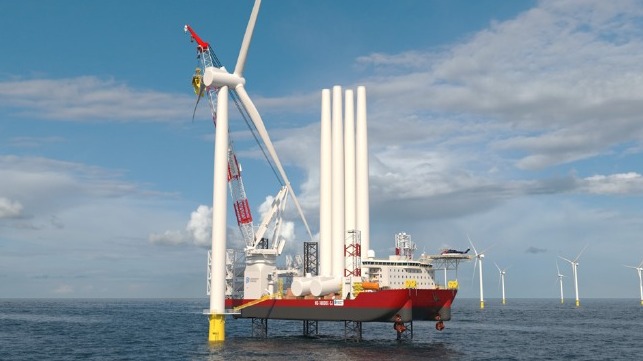White Houses Prioritizes Ships and Supply Chain for Offshore Wind

To support the current offshore wind developments and accelerate the pace of growth for the industry, the White House today announced new federal initiatives in partnership with the governors of 11 states spanning from Maine to North Carolina. The partnership is designed to support efforts to provide Americans with cleaner and cheaper energy by focusing on the supply chain and critically the shortage of installation vessels.
The Biden administration outlined and is pursuing an aggressive plan that calls for expanding America’s offshore wind capacity from its current level of just over 40 MW to reach 30 GW by 2030. Announcing their new initiatives, the White House pointed to strong progress. They estimated that there is the opportunity for $109 billion in revenues across the offshore wind supply chain this decade. They pointed to investors announcing $2.2 billion in new funding in 2021, including commitments to develop nine major manufacturing facilities to produce the foundations, towers, cables, and blades of offshore wind turbines. In addition, supplier contracts to provide materials and services to offshore wind projects more than doubled.
Despite the rapid growth, or possibly because of it, experts have pointed out that the supply chain is currently too limited to support the needed levels of commercial-scale offshore wind energy deployment. In April 2022, the National Renewable Energy Laboratory of the U.S. Department of Energy, along with the Business Network for Offshore Wind, and DNV, mapped the requirements pointing out the lack of capacity to meet the projections. Saying that the ongoing efforts to develop the domestic supply chain have been focused on individual state levels, they called for a comprehensive assessment of how to strategically develop a supply chain that benefits the entire industry and country is needed.
The Business Network for Offshore Wind, a non-profit focused on developing the offshore wind industry and its supply chain, issues a statement supporting the new initiative. “This federal-state offshore partnership is a critical step towards unlocking supply chain growth and helping the industry scale to keep pace with demand,” said Liz Burdock, CEO and founder of the organization. “Along our coasts, the supply chain is coming to life with new manufacturing facilities, ports being rebuilt, and shipbuilding activity. With global demand growing exponentially, we need to accelerate this progress to reach our clean energy goals.”
Launching the new Federal-State Offshore Wind Implementation Partnership the governors and White House committed to collaboration on expanding key elements of the offshore wind supply chain, from manufacturing facilities to port capabilities and workforce development. The partners will work together to build a strong, U.S.-based supply chain for offshore wind and grow the U.S. workforce for the industry. At the same time, it creates the first forum to address important regional matters such as transmission and interconnection, fishing, and other ocean co-use issues.
In addition to addressing other issues contained in the report on the requirements of the supply chain, as part of the new program, The Department of Energy, along with New York and Maryland, is providing funding to develop a comprehensive offshore wind supply chain roadmap. It will focus on the supply chain needs, including manufactured components, ports, and vessels, required to deploy 30 GW by 2030. As part of it, the Department of Energy will host a workshop in July for stakeholders, including state officials, to provide input on a roadmap laying out actions to meet the supply chain needs.
Seeking to address the shortage of ships for the offshore wind industry, the Maritime Administration (MARAD) is announcing the designation of offshore wind vessels as “Vessels of National Interest.” By taking this step, the administration is prioritizing applications for these vessels in the Federal Ship Financing Program. The program assists the domestic shipbuilding industry, providing support for U.S. shipyards to modernize their facilities, to build and retrofit vessels, and assists U.S shipowners to cost-effectively obtain domestically produced new vessels.
An analysis by Norwegian firm Rystad Energy reported in 2020 that there were only 32 wind turbine installation vessels in the world. While several high-profile orders have been placed in the past two years, the U.S. continues to lag with companies citing the high cost of building these specialized vessels in U.S. yards. One solution to meet the Jones Act requirements might be the use of feeder vessels, but there too the U.S. is considered to be lacking. The first contacts have been awarded to the U.S. shipbuilding industry with the anticipation that the offshore wind industry could significantly contribute to U.S. shipbuilding in the next few years.
The administration said the new initiatives are designed to better unify and leverage the resources to accelerate the development of the offshore wind industry. They look to utilize the funds from the lease auctions to support the development of the supply chain, labor, and manufacturing required. While the effort is initially focused on the U.S. East Coast, they plan to expand it to include the Pacific Coast and the Gulf of Mexico as those areas move forward with their first wind power development projects.
